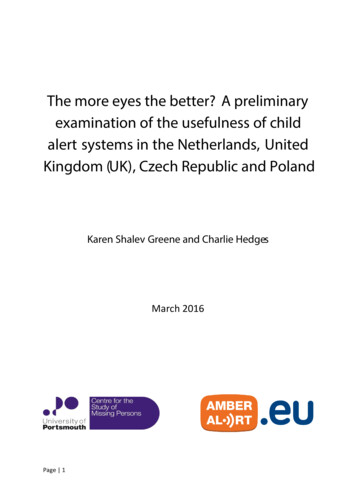
Transcription
The more eyes the better? A preliminaryexamination of the usefulness of childalert systems in the Netherlands, UnitedKingdom (UK), Czech Republic and PolandKaren Shalev Greene and Charlie HedgesMarch 2016Page 1
FOREWORDThe Centre for the Study of Missing Persons (CSMP) is a specialist research centre withinthe Institute of Criminal Justice Studies, at the University of mic/icjs/csmp/ ). The Centre was founded inApril 2012, in partnership with the charity Missing People, to accommodate the growinginterest in the field of missing persons. It aims to provide a clear focus for research,knowledge transfer and educational provision to academics, professionals in this communityand relatives of missing people. The Centre also aims to function as a one-stop knowledgeresource which researchers and other interested parties can access, and use to communicateand exchange knowledge about missing persons.Dr. Karen Shalev Greene (Karen.shalev-greene@port.ac.uk or csmp@port.ac.uk), Director of theCentre for the Study of Missing Persons, Institute of Criminal Justice Studies, University ofPortsmouth, St. George's Building, 141 High Street, Portsmouth, PO1 2HY, Tel: 44 (023)92843938AMBER Alert Europe is the European Child Rescue Alert and Police Network on Missing Children(http://www.amberalert.eu). It is an international not for profit organisation dedicated to theprotection of endangered missing children and connects citizens with law enforcement when thepolice believe the public can help save the child’s life. It has 22 members (law enforcement,ministries and NGOs) in 16 countries. Its Police Network consists of over 35 experts representing lawenforcement from 12 countries. The goals of AMBER Alert Europe are backed by 150 Members ofthe European Parliament.Charlie Hedges MBE (Charlie.hedges@amberalert.eu), European Alert Coordinator Police Specialist,Missing Children AMBER Alert Foundation, Rond-point Robert Schuman 9, 1040 Brussels, Belgium.The authors of this report would like to acknowledge the effort and thank the participantswho took part in this study and completed our survey.Page 2
AbstractWhen a child alert system is activated law enforcement agencies rapidly disseminate informationabout the abducted child and their abductors to the public via media broadcasters. The aim of thisstudy is to examine officers’ opinions and experiences of using child alert systems in cases from theNetherlands, UK, Czech Republic and Poland. 14 participants in roles related to the use of alertsystems and where the system had been used were approached by the researchers to ask if theywould be willing to participate. The findings show that child alert systems have the potential to leadto the quick and safe recovery of an abducted child, as well as other important benefits, such assupport the investigative process, improve the relationship between law enforcement and thechild’s relatives, and meet public expectations. The study also raises areas of concern, where the useof child alert systems may challenge the investigative efforts in terms of the management of callsfrom the public, volunteers and search efforts and added public scrutiny.Page 3
EXECUTIVE SUMMARYThe aim of this study is to examine officers’ opinions and experiences of using child alert systems incases from the Netherlands, UK, Czech Republic and Poland. The purpose of the alert was originallycreated to provide a rapid response to the most serious child abduction cases, where a child is takenand is feared to be in imminent danger of serious bodily harm or death (Sicafuse & Miller, 2010, p.1238). When an alert is activated law enforcement agencies rapidly disseminate information aboutthe abducted child and their abductors to the public via media broadcasters (TV, radio, social media,road signs, mobile phones, etc.).The first child alert system was created in Texas, US in 1996 and, at this time, 23 countries aroundthe world have similar alert systems. Several studies have highlighted the benefits of using a childalert system as well as 4 areas of its limitations. To date, the body of research evaluating child alertsystems has been carried out in the US. Given its international use, there is a gap in knowledgeregarding its use in European countries. Furthermore, previous research tries to determine itseffectiveness, i.e., how successful these alerts are, using data from solved cases. However, as theliterature establishes, the potential benefits of child alert systems are more multifaceted thanwhether or not the child was recovered alive. Thus, this study examines the broader issuessurrounding the usefulness of child alert systems.14 participants in roles related to the use of alert systems and where the system had been usedwere approached by the researchers to ask if they would be willing to participate. Participants fromthe Netherlands, UK, Czech Republic and Poland responded to the online survey. The participatingcountries in this study are among the most active users of child alert systems and issued 82% of allchild alerts in the EU in 2015. The online survey was opened 17th September 2015 and closed on17th January 2016. A total of 30 questions were presented to the respondents, which consisted ofopen and closed questions.Given the exploratory nature of this study and the small sample, it is not possible to generalise ourfindings. However, according to our participants the majority of children in these types of cases wereaged 10 or younger, and were mostly females. Cases included a mixture of stranger child abduction,parental abduction, kidnap, and lost/missing. In the majority of cases, according to participants, thealert system was activated 3 or more hours after the child was reported missing/abducted, and inmost cases the child was found alive. These findings are similar to previous findings from the US(NCMEC, 2015).There is no doubt the main goal of child alert systems is to lead to the quick and safe recovery of anabducted child. The study suggests the use of child alert systems has the potential to do that, as wellas other important benefits, such as support the investigative process, improve the relationshipbetween law enforcement and the child’s relatives, and meet public expectations. The study alsoraises areas of concern, where the use of child alert systems may challenge the investigative effortsin terms of the management of calls from the public, volunteers and search efforts and added publicscrutiny.It is our hope that the results of this study will enrich the discussion regarding the use of child alertsystems and encourage research to be carried out and explore these issues even further. Westrongly recommend that future research will examine actual case files and actions generated as adirect result of child alert systems, and evaluate whether information received from the publicfollowing an alert system lead to information that was used to apprehend an offender and/or assistin their prosecution and conviction.Page 4
1.IntroductionThe AMBER (America’s Missing: Broadcast Emergency Response) alert system was created in Texasin 1996 as a result of the abduction and murder of 9 year old Amber Hagerman (Donnellan, 2001;Griffin et al, 2007). The purpose of the alert is to provide a rapid response to the most serious childabduction cases, where a child is taken and is feared to be in imminent danger of serious bodilyharm or death (Sicafuse & Miller, 2010, p. 1238). When an alert is activated law enforcementagencies rapidly disseminate information about the abducted child and their abductors to the publicvia media broadcasters (tv, radio, social media, road signs, mobile phones, etc). This is becausechildren who are abducted in such cases are typically murdered within the first 3 hours (Boudreauxet al., 1999; Hanfland et al., 1997; Newiss & Traynor, 2013). Thus, a rapid enlistment of the public aspotential witnesses could lead to the child’s quick and safe recovery.By 2005, all 50 states joined the national AMBER alert system. Since 1996, 23 countriesaround the world created similar alert systems (ICMEC, 2016a), which use different names,such as, child abduction alert, child rescue alert, etc. While each alert system is unique, withcommunities and countries developing their own criteria and ways of disseminating theinformation about the abducted child, the concept remains the same. Therefore, for thepurpose of this report, they will now be referred to as child alert systems.In a declaration adopted on 2 September 2008, the European Parliament called on theMember States to put alert mechanisms in place and to conclude cooperation agreementsto allow for cross-border alerts. They set the minimum common criteria1 to be: 1. Thevictim is a minor (under 18 years of age); 2. It is a proven abduction or there are clearelements indicating that it could be the case of abduction; 3. The health or life of the victimis at high risk; 4. Information is available which, once disseminated, will allow the victim tobe located; 5. Publication of this information is not expected to add to the risk facing thevictim.Not all counties have exactly the same operating methods for activating alerts but in allcases it will be necessary for the police officer investigating the missing child to considerwhether or not an alert is required. It is then generally the case that there will be someform of central support that can enable the activation of the alert and notify the media andthe public. The more sophisticated systems will enable the automated dissemination ofinformation nationally, regionally or locally and to those outlets that are appropriate to thecase.1Some countries in Europe have altered their criteria to remove the requirement for thereto be abduction and, for example, include missing children where their life is in imminentdanger (NL) or focus on the risk to the child rather than the circumstances (UK).Page 5
Donnellan (2001) and Zgoba (2004) highlight several benefits of using a child alert system.From a social perspective, (1) they are a powerful tool for law enforcement and a way forbroadcasters to contribute to and engage with their community. (2) Extensive coverage candramatically increase law enforcement’s ability to locate witnesses and help resolve thesecases more quickly; (3) Once an alert is out it engages the entire community to mobilise andassist with recovering the child and apprehend the offender; (4) An alert provides a sense ofsecurity to parents, caregivers as well as to the general public (Griffin, 2010).The practical benefits are that (1) the alert is immediate and media broadcasters will receivethe information quickly and simultaneously; (2) It is inexpensive to activate; (3) Broadcastersthat use digital equipment and signals will be able to interrupt programming automatically.This benefits stations and systems that are not staffed 24 hours a day; (4) It is easilyaccessible to the public and can be received via their mobile phones, social media accounts,pagers and other devices, not only TV and radio.Despite numerous success stories (NCMEC, 2016, ICMEC 2016b, AMBER Alert Europe, 2016)and support from the general public, policy makers and law enforcement (Sicafuse & Miller,2010), there have been concerns regarding the effectiveness in four distinct areas:1. Regardless of its intention to focus on only the most serious stranger child abductioncases, alerts have been issued on a much wider basis, including familial abductions, lost,injured or otherwise missing, endangered runaways and benign or even hoax cases(Hargrove, 2005; Griffin, 2010; Griffin et al, 2007, NCMEC, 2015). There is evidence that themost successful returns are in intra-familial abductions, rather than in stranger abductions,which boosts percentages of success rates but not necessarily in life threateningcircumstances (Griffin, 2010).2. The system assumes members of the public will recognise suspects and/or victims whenthey encounter them, and that they will be able to report them to the police (Miller &Clinkinbeard, 2006; Miller et al., 2009). However, a large body of research repeatedlyquestions people’s ability to process, remember, and recognise information related to theidentification of the other persons (pg. 4) (for example, Frowd, et. al., 2012; Gier et al.,2011; Lampinen et al., 2012, 2014, 2015; Sweeney & Lampinen, 2012).3. The system assumes members of the public will be willing to report any sighting of theperpetrator and/or victim to the police. However, bystander intervention (also known asbystander effect) research suggests that people are not always willing intervene in anemergency situation (Hortensius & de Gelder, 2014; Levine, & Manning, 2013).4. It is widely believed that most perpetrators who intend to kill their young victims do soimmediately or shortly after the abduction (Boudreaux et al., 1999; Hanfland et al., 1997;Newiss & Traynor, 2013). However, most alerts are not issued in time to save the child’s life(Griffin et al., 2007; Sicafuse & Miller, 2010).Page 6
To date, the body of research evaluating child alert systems has been carried out in the US.Given its international use, there is a gap in knowledge regarding its use in Europeancountries. Furthermore, previous research tries to determine its effectiveness, i.e., howsuccessful these alerts are, using data from solved cases. However, as stated above, thepotential benefits of child alert systems are more multifaceted than whether or not thechild was recovered alive. Therefore, the aim of this scoping exercise is to examine officers’opinions and experiences of using child alert systems in child abduction cases from theNetherlands, UK, Czech Republic and Poland.2.MethodOut of the 28 European member states, 16 European countries have child alert systems andonly 8 EU member states have used the system at least once. The participating countries inthis study are among the most active users of child alert systems and issued 82% of all childalerts in the EU in 2015. These 4 countries issued 19 alerts in 2015 out of 23 alerts in total.By the very nature of child alerts, the amount of usage is small, which inevitably leads to asmall sample size. Persons responsible for alert systems in seven countries where thesystem had been used were approached by the researchers to ask if they would be willing toparticipate. This was done by email, telephone or meeting. They were then asked toidentify personnel with experience in using the child alert to participate in the survey. Thesample consists of 14 participants in roles related to the use of alert systems and whoseidentities are anonymous.In order to maintain the anonymity of participants, there will not be any discussionregarding specific details of the cases officers were involved with.The online survey was done via SurveyMonkey. The online survey was opened 17thSeptember 2015 and closed on 17th January 2016. A combination of open and closedquestions was identified as being appropriate (see a template of the survey in appendix 1).Closed questions (dealt with through a ‘radio button’ response) were used to generate thequantifiable data that was sought. Open questions (that invite unstructured narrative fromthe respondent) were included to ensure that an appropriate depth of qualitative data wasalso collected.A total of 30 questions were presented to the respondents. None of them were mandatoryand the explanation was given that any of the questions could be skipped if required. Therewere a total of 6 completely closed questions (radio button response), 8 questions thatwere closed, but allowed for a supplementary narrative response and 6 completely openquestions inviting free narrative.Page 7
3.ResultsOverall 14 participants took part in the study. Countries represented in this study are theNetherlands (6), UK (4), Czech Republic (2), and Poland (2).Participants’ roles:The roles of participants were fairly varied. One participant did not provide any information. Investigating officer x7Experts/advisor x4Spokesperson x2Years of police/investigative experienceAll of the participants in this study had a long working experience within lawenforcement with 2 participants working 11-15 years and 11 participants with over 16year experience.Previous experience working on missing children casesNumber of cases worked on8765432101 to 1011 to 5051 to 100Over 100The table shows a fair variation in previous work experience of participants in working onmissing children cases. However, half of the participants had an extensive experience.Experience with cases related to child alertsWhile most participants had limited experience with child alert systems, 3 participants had amore extensive experience.Page 8
Experience of cases related to child alerts1210864201 to 56 to 1011 to 50Over 50Age of child subject to the alert (N 11)It seems that child alert systems are issued in cases where children are more likely to bevery young, i.e. 10 years old or younger (8). 3 participants indicated 11 to 15 years old werealso subject to an alert. It is important to note that this is a general overview based onparticipants recollection, rather than statistical data based on case files. However, it issimilar to previous findings (NCMEC, 2015, p.19; AMBER Alert Europe, 2016).Gender of child subject to the alert (N 11)Participants in this sample indicated that it is more common for cases involving girls (7) tobe subject to an alert than boys (4). While this is based on participant’s recollection ratherthan official data, the findings are supported by previous findings (NCMEC, 2015, p. 17;AMBER Alert Europe, 2016).Type of case (N 11)For the purpose of this study, cases of child alerts were categorised into 5 categories ofcases, similar to types used in AMBER alert cases in the US (NCMEC, 2015, p. 6): Stranger abduction- cases where there was an unauthorised taking, retention,luring, confinement, or concealment of a child younger than te age of 18 bysomeone other than a family member.Family abduction- cases involving the taking, retention or concealment of a childyounger than 18 years of age, by a parent, other person with a family relationship toPage 9
the child, or his or her agent, in violation of the custody rights, including visitationrights of a parent or legal guardian.Kidnap- Cases where a child younger than 18 years of age is restrained against theirwill and transported a substantial distance or held in a place of isolation through theuse of force. Kidnapping statutes also define a set of purposes for kidnappingincluding: collecting ransom, facilitating the commission of a felony, inflicting bodilyinjury, or terrorizing someone (Criminal Law- Free Advice, 2016).Lost or missing- any missing child younger than the age of 18 where there areinsufficient facts to determine the cause of the child’s disappearance or any child 10years or younger who is missing on his or her own accord.Trafficked- the movement of children younger than the age of 18 for the purpose oftheir exploitation (Unicef, 2007)Type of cases4.543.532.521.510.50StrangerAbductionFamily abductionKidnapLost/MissingTraffickedThere is no information about the level of risk of harm identified for each of these casesprior to activating the alert. It is worth noting that there may be some overlap betweenabduction and kidnap cases as there is variation in use of categories between countries.However, the main finding here is that, as previously discussed, child alert systems are usedto a wider type of cases than originally designed.It is also important to highlight that almost half of participants (5 out of 11 who answered),indicated that these type of cases involve collaboration with other countries. 4 participantsclaimed they were involved with 2 other countries, which one participant stated they wereinvolved with 3 other countries.Page 10
Time between reported missing and activation of alert (N 10)4 participants indicated that it only took 1 to 2 hours for the activation of the alert system. 6participants indicated that it took 3 to over 11 hours. Overall, 70% of the alerts wereactivated within 5 hours. This is an important finding due to academic literature suggestingthat children who are abducted and murdered, they are likely to be killed within the first 3hours (Boudreaux et al., 1999; Hanfland et al., 1997; Newiss & Traynor, 2013). However, it isimportant to be aware that the sample did NOT include child abduction/homicide cases,thus the time frame of 3 hours is not relevant to the sample but demonstrates the capabilityto launch an alert quickly.Time between reported and activation ofalert4.543.532.521.510.501 to 2 hours3 to 5 hours6 to 10 hours11 hours or overTime alert was in place for (N 10)Once a child alert system was activated it was in place for several hours, ranging between 3to over 24 hours.Page 11
Time alert was in place3.532.521.510.501 to 3 hours3 to 5 hours6 to 10 hours11 to 24 hoursOver 24 hoursOutcome of cases (N 10)The outcome of cases seem to be varied with half of participants indicated children werefound alive, while the other half stated that children were found deceased. One participantindicated that the case is open as the child has still not been recovered and the case remainsopen.Outcome of cases1Child found alive54Child found deadChild not found and case isopenWhen participants were asked whether they thought the child alert system assisted to findthe child 5 participants responded positively. The other 9 participants did not respond toPage 12
this question. Participants explained why they believed the alert directly assist resolvedthese cases: Public pressure the offenders surrendered to the authoritiesThe child was identified by a member of the publicThe alert and coordination that followed led to a police force in a different countryfound the child and brought them to safetyMembers of the public volunteered to search for the child, which assisted thepolice’s effortsThere was an integrated rescue system which was very usefulType of media used for an alert (N 10)Alerts were broadcasted via multiple outlets, in no particular order and on a national level: TVSocial mediaText messaging (SMS)Digital advertisingTraffic signsRadioNewspapersPublic response to the child alert system (N 10)Overall, the public response was fairly positive, if not intense, with most participants statingthey received hundreds or thousands of calls from the public. It is recommended that futurestudies using case files will generate objective accounts as to the exact number of calls fromthe public in each country, and ascertain whether there are differences in public response toalerts between countries and type of cases.Page 13
Calls from the public3.532.521.510.500 to 5051 to 100101 to 500501 to 1000Over 1000Effective use of media in informing the public of an abducted child (N 10)Participants were asked to assess from their own experiences how effective were thedifferent types of media in relation to informing the public of the abduction of the child.Most responses were very positive, with TV, radio, Internet, social media, newspapers andapps viewed as the most effective types of media to assist in informing the public.Participants were more mixed in their assessments of the effectiveness of digital advertisingboards and traffic 0Moderatelyeffective00000001Effective netSocial mediaSMSAppDigitaladvertisingTraffic signs20200*One participant answered ‘not effective’ where type of media was not utilised.Total996975474It is important to note that this finding is based purely on the participants’ subjectiveassessment rather than an objective test, and due to the small number of participants thesefindings cannot be generalised. Furthermore, the effectiveness of some cases might dependPage 14
on the case itself. For example, traffic signs will be mostly effective when there isinformation about the vehicle of an abductor (license plate, etc.). Thus, we encourage futurestudies to examine this issue further.Effective use of media in recovery of children (N 10)Participants were asked to assess from their own experiences how effective were thedifferent types of media in relation to the recovery of the child. Most responses were fairlyneutral or positive, with TV, SMS, Internet and social media as deemed the most effectivetypes of media to assist in recovery of child. Participants were more mix in theirassessments of the effectiveness of radio, newspapers, apps, digital advertising boards andtraffic 1Moderatelyeffective35332111Effective netSocial mediaSMSAppDigitaladvertisingTraffic signs20100*One participant answered ‘not effective’ where type of media was not utilised.Total101071054353It is important to note that this finding is based purely on the participants’ subjectiveassessment rather than an objective test, and due to the small number of participants thesefindings cannot be generalised. However, we would encourage future studies to examinethis issue further.Impact of publicity of child’s safety (N 10)One of the main concerns officers often express, in informal conversations, in relation toactivating child alert system is that publicity may put pressure on the offender and the childwill come to harm as a result. When asked about this, participants gave mixed responses. Negative impact was in one case where as a result of the publicity a parent left thecountry with the children who were abducted.Positive impact was in a case where the children were identified by members of thepublic and in a case where the parent surrendered to the police as a direct result ofthe publicity and public pressure.Page 15
No impact was in a case where the child was murdered before the child was evenreported missing.It is recommended that future studies will examine case files where child alert systems wereused and ascertain (where possible) whether or not an alert had any direct impact on thechild’s safety.Training and awareness of the alert system (N 13)The vast majority of participants (12) had some previous knowledge of the alert system.Only one participant did not. 12 participants also indicated that they received some trainingabout the alert system, but 4 out of 12 participants stated it was only after considering usingit.Training took place in the form of: Information available on InternetRegional and/or national workshops and conferencesLive or simulated exercisesThe training consisted of: Police procedure (Guidelines, criteria for issuing an alert)Types of searchCooperationCommunication with the publicPsychological support to relativesBenefits of using a child alert system (N 10)Participants were asked to assess in the own words and from their own experience the mainbenefits in using a child alert system in relation to: The investigationo The child alert reassured officers that all that could be done was being doneto locate the childo The child alert reassured the public that all that could be done was beingdone to locate the childo The public was engaged with the case and the investigationo As a result of the publicity officers received quality information from thepublic that led to new tactical options.o The set-up of an a child alert system facilitated good cooperation betweenvarious agencies and EU countriesPage 16
Relationship between police and family of abducted childo The use of a child alert system seem to strengthen the relationship betweenlaw enforcement and relatives of the child, as they are reassured that all wasbeing done to find the child.o In some cases of parental abduction/homicide, the publicity and publicpressure led to parent’s confession.o In cases where the parent was the abductor and case was resolved in anarrest and conviction, the child alert system laid the foundation to aneffective relationship with the wider family of the child.Public expectation- A child alert system leads to public interest and involvement inthese cases. As a resulto The public has a sense of involvement with safeguarding the children in theircommunity.o Mobilises the public to assist in search efforts.o The alert and increase communication with the public about the case andinvestigation enhanced understanding of police work and improved itscredibility.Safety of the childo The more eyes the better. Participants indicated previously that in a numberof cases public exposure led to the resolution of the case and safe return ofthe child.Challenges of using a child alert system (N 10)Participants were asked to assess in the own words and from their own experience the keychallenges in using a child alert system in relation to: The investigationo The volume of calls generated in a short timeframe can be challenging interms of assessing the information and prioritising the action required.o The volume of volunteer searchers can be challenging in terms ofcoordination, systematic approach and safety of the public.o There is a need to ensure that officers have resources, are appropriatelytrained and equipped place before the launch of the alert in order to meetthe demand.Relationship between police and family of abducted childo Consideration must be given to the scope of published information on thechild and/or familyo Law enforcement must be understanding of family concernsPublic expectationo Child alert systems lead to an even greater public expectation.Page 17
4.Safety of the childo There is always a risk of unexpected and dangerous actions of a perpetratorDiscussion and ConclusionsChild alert systems have been used in Europe since 2006. While previous research has beendone in the US about the use of such systems,
The first child alert system was created in Texas, US in 1996 and, at this time, 23 countries around the world have similar alert systems. Several studies have highlighted the benefits of using a child alert system as well as 4 areas of its limitations. To date, the body of research evaluating child alert systems has been carried out in the US.











